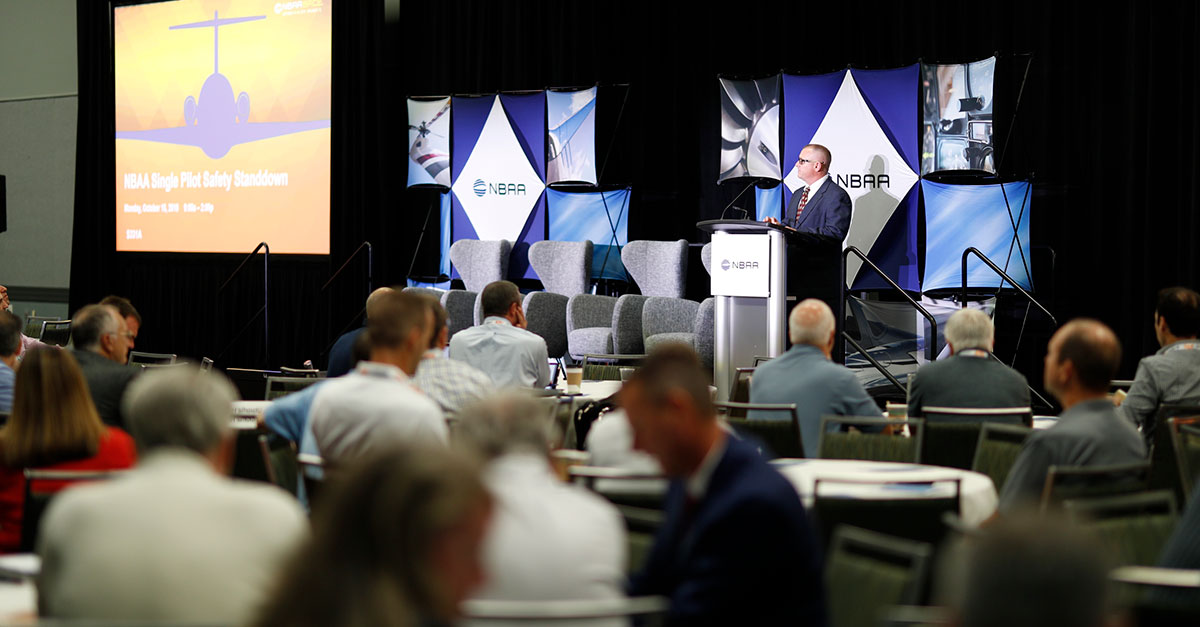Risk Mitigation in Focus at 10th Annual Single-Pilot Safety Standdown
Oct. 15, 2018
More than 150 attendees focused on practical, realistic risk mitigation strategies for some of the top causes of single pilot accidents and incidents at the Single-Pilot Safety Standdown, which took place Oct. 15, prior to the opening of the NBAA Business Aviation Convention & Exhibition (NBAA-BACE).

Wright Brothers Master Pilot Bill Crutchfield, founder of the Crutchfield Corp., shared his experience and perspectives gained from more than 50 years of safe flight, encouraging attendees to consider the impacts of sleep deprivation, stress, after-effects of alcohol and other physical conditions on their critical thinking skill while flying. He also urged attendees to care for their health to ensure long, successful aviation careers.
“The concept of being past one’s prime at 65 is outdated,” said Crutchfield, who added a key to longevity is remaining active in a chosen profession or pastime. In his case, this means staying involved in his business and remaining an active pilot while imposing some personal limitations, such as not flying late at night.
Dan Ramirez, director of safety at XOJet, presented accident data collected from sources including the NTSB, ICAO and various industry databases.
For single-pilot operations, runway excursions, loss-of-control in flight, runway overshoot/undershoot and controlled flight into terrain are the top causes of accidents and incidents, with piston aircraft having a higher accident rate than turboprop or turbine aircraft.
NBAA COO Steve Brown, AOPA President and CEO Mark Baker and EAA CEO and Chairman of the Board Jack Pelton discussed single-pilot safety and leadership from the perspective of each association.
“All of us can lead from anywhere, regardless of our formal position,” said Brown. “We all have influence within our own spheres. We need to look at ourselves and think about what we can do within our own organizations to improve safety.”

“Be humble. Be willing to share your mistakes. Share what went wrong, what almost went wrong,” added Baker, as he encouraged attendees to spend time at their local airports sharing their experiences with young pilots.
Attendees split into small breakout groups and were guided by subject matter experts in developing practical mitigation strategies, including setting personal limitations and standards, completing a flight risk assessment tool prior to flight and developing and implementing stabilized approach criteria to reduce the risks of these four top causes of accidents and incidents. In some cases, the risk mitigation strategy was simply to delay or cancel the flight and use another mode of transportation.
A panel of experienced single pilot operators shared how their aircraft benefit their businesses and discussed their own safety mitigation efforts, including formal training programs which exceed regulatory or insurance requirements and special emphasis scenario-based training like mountainous operations and approaches.
Any person who attends an NBAA convention, conference, seminar or other program grants permission to NBAA, its employees and agents (collectively "NBAA") to record his or her visual/audio images, including, but not limited to, photographs, digital images, voices, sound or video recordings, audio clips, or accompanying written descriptions, and, without notifying such person, to use his or her name and such images for any purpose of NBAA, including advertisements for NBAA and its programs.


 International Business Aviation Council Ltd.
International Business Aviation Council Ltd.